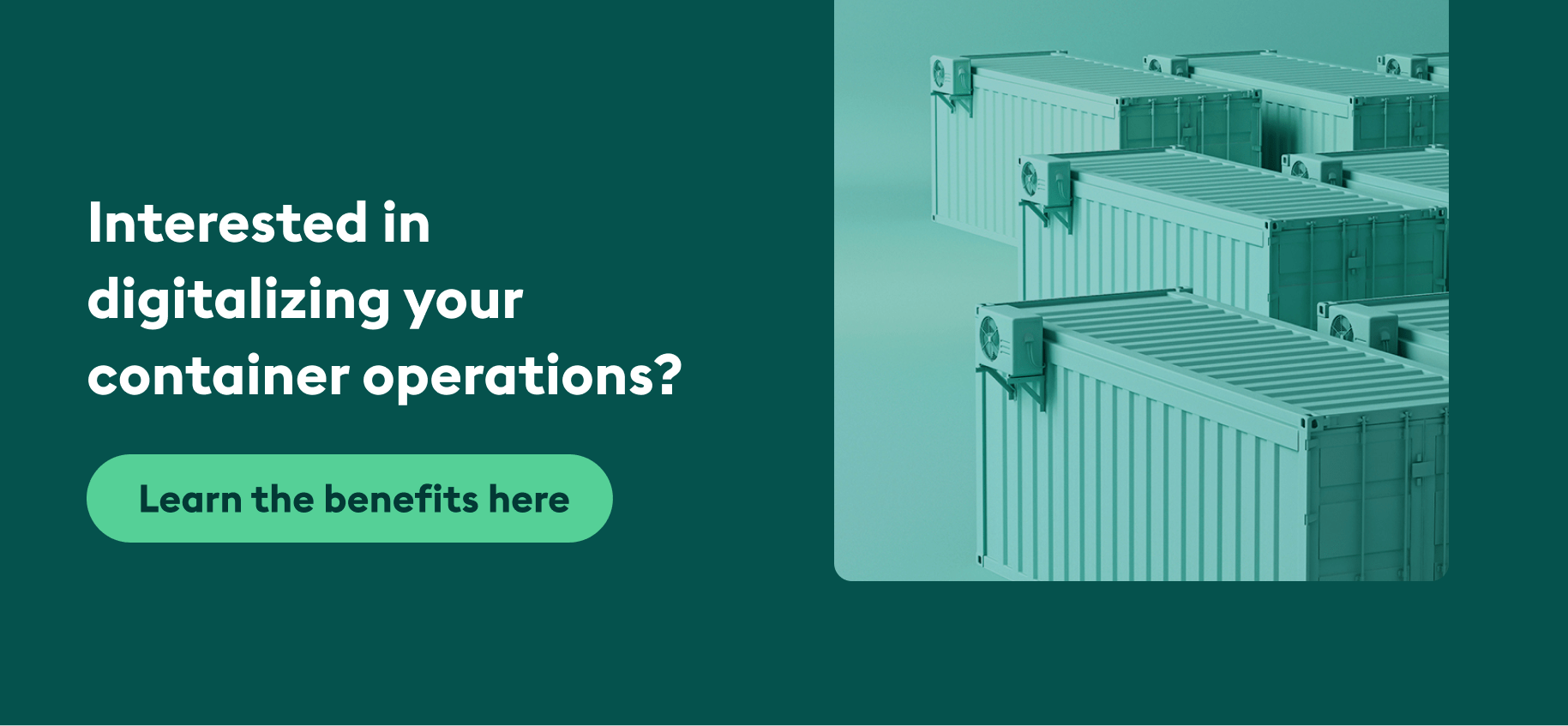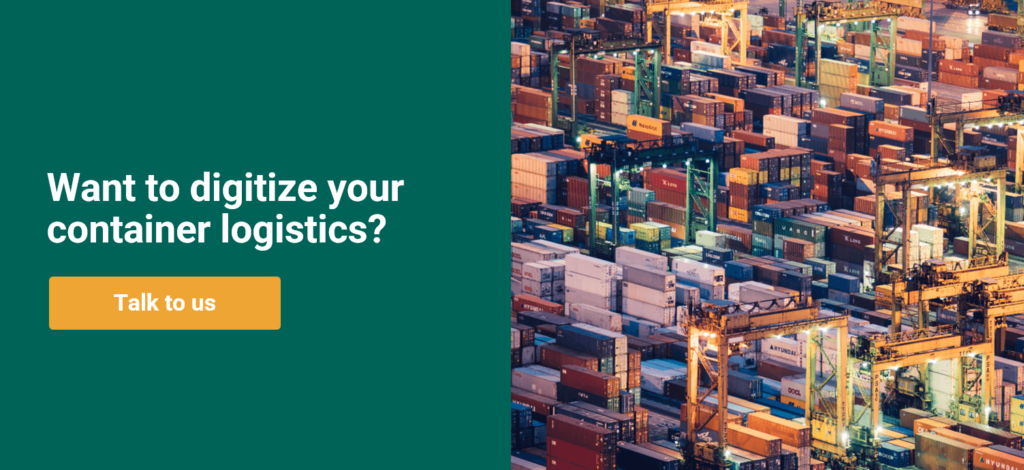For the smooth functioning of the shipping industry, specific data should be maintained and updated from time to time. Thankfully, there’s the EDI shipping system to automate the entire process. It collects the required data and saves time and resources. Read on to know more about EDI and how it can help in your shipping and logistics business.
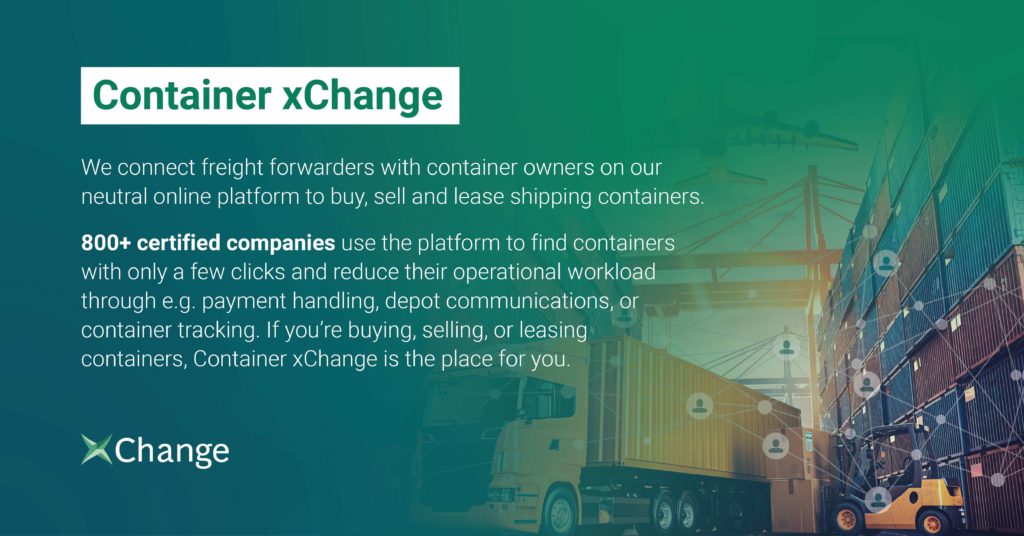
Ever thought how easy it would be to get all your shipping business-related data digitally? Imagine, no more running around carrying important documents that you constantly fear losing. Ah! Just the thought of it gives us a sigh of relief. If you felt that too, you’ve stopped at the right place.
In this digital era, paper-based documents are replaced by electronic format. And the shipping industry is no stranger to that. This is where the EDI shipping system enters as the hero! It makes all the documents you need about your shipping process accessible at your fingertips. Before we delve more into it, let’s understand what exactly EDI means and how it works.
What is EDI shipping?
EDI or Electronic Data Interchange in simple terms means the exchange of business documents between two parties (companies). It has a standard electronic format. In the shipping industry, the EDI shipping system helps manage the documentation for:
- Purchase orders
- Bill of lading
- Details of the warehouse
- Shipping details
- Customs documents
- Inventory documents
- Shipping status documents
- Payment documents
- Invoices and advance ship notices
It instantly generates and downloads the required documents into the receiver’s system. This ensures no human intervention. Thus, the data transfer process is faster, easier, efficient, and error-free.
How does EDI work?
Usually, there’s EDI software to collect all the required data. Here, text files are used to exchange this data. EDI is one of the most popular communication and data transfer technologies used today. Since it uses standardized electronic formats, computer systems can process information effortlessly.
Let’s get a visual understanding of how the EDI system works with an example. Suppose, you are buying bulk fabric from a vendor. In order to get the process started, you have to first submit a purchase order. Following are the steps you have to follow:
Step 1: Entering
Your first step is to enter the data manually through a series of screens. After which,
- Export information stored in your computer network.
- Use the electronic reports which have been reformatted into data files.
- Augment an existing application that automates the file creation process, so information is almost immediately ready for EDI transfer.
- Utilize an application that has built-in interfaces for EDI files.
Step 2: Sending
- Send the data through translator software. The translator software will then convert the information into a standard EDI format.
- Outsource the data translation to an EDI provider.
Step 3: Connecting
- Connect directly through a secure Internet protocol
- Connect through an EDI network provider (who connects you and your vendor via an agreed-upon protocol)
- A combination of the above two methods.
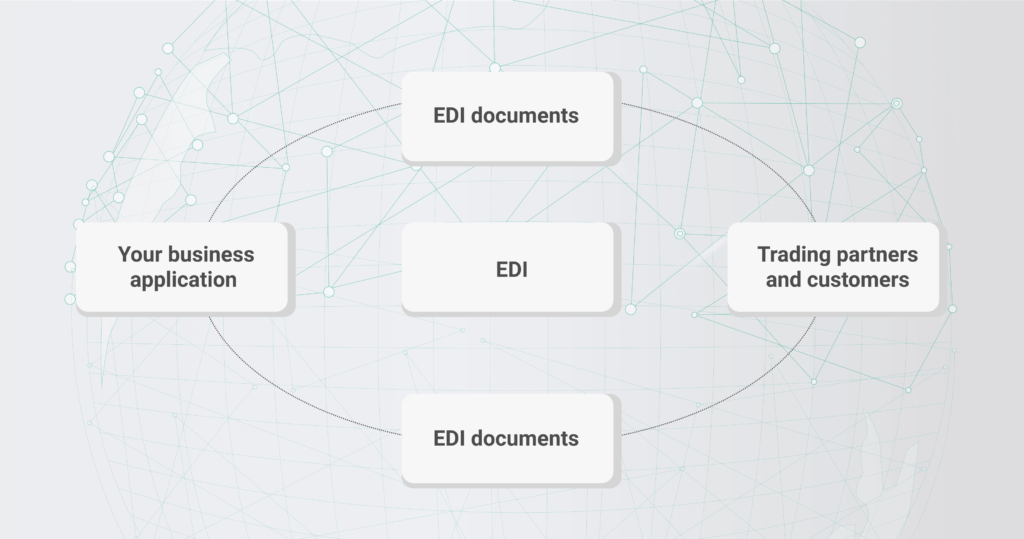
Does this seem like a lot to keep tabs on? We get it but you actually don’t have to. On Container xChange you can have all your documents related to your containers and shipments in one place. Digitizing your logistics can help you save time – and minimize your worries. Want to know how xChange can help you save time and money, and automate your sales offers? Click the banner below for a quick tour.
Example of EDI in the shipping industry
EDI solutions provide access only to pre-defined authorized users. Thus, it makes it the safest way to transmit data. In the shipping industry, businesses can send large quantities of documents with a single transfer using EDI software.
As you know, there are many parties involved in the maritime industry – shippers, shipping lines, consignees, port authority, customs, and so on. Regardless of where you are in the supply chain, you communicate with several of these companies. Each of them has a specific purpose. So, by the end of an operation, you’ll have shared many messages, documents, and data.
Let’s understand the use of EDI in the shipping industry with an example.
Company A sends a purchase order (PO) to Company B. On receiving the PO, a sales order will be automatically generated in Company B’s system with the help of EDI software. Here, the buyer’s need is digitally acknowledged at a lighting speed – thanks to the EDI integration. Both the companies’ communication is instant, highlighting company B’s business efficiency and ultimately improving A and B’s trading relations.
Want to know how you can benefit from integration with xChange? You can jump down to it right now
Advantages of using EDI shipping
There are many benefits of using EDI in logistics. And we can’t stress it enough. It helps you optimize workflow in a systematic manner and ensures quicker response time. Additionally, you can take up more business operations with fewer human resources.
Let’s dive into the advantages to understand how EDI technology can boost your business.
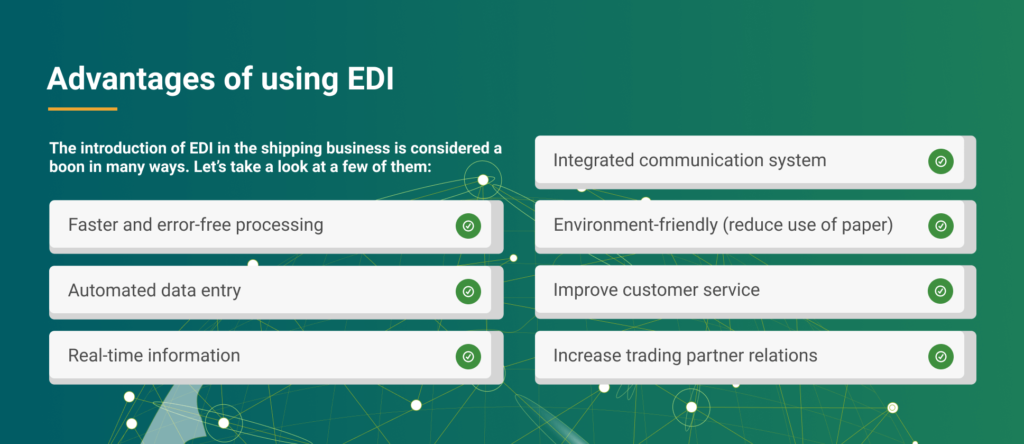
Faster and error-free processing
EDI has diminished the use of manual data entry and transformed the traditional method of paperwork. Since there is less to no human interference with EDI integration, the chances of errors are nil. This also makes the documentation and data processing faster and efficient.
Automated data entry
One good thing about digitization is it automates everything. With an EDI system, you can now enter your data automatically by using EDI software. From data validation to receipt verification, every step of the process is done automatically, hence leaving less or no room for errors. Be rest assured, the information you are sending and receiving is digitally acknowledged.
Real-time information
The introduction of EDI in the shipping industry is considered a boon in many ways. One of them is accessing real-time information. This helps avoid possible delays in sending or receiving data/documents. The fact that EDI is a tech-based process, it helps to keep track of important documents effortlessly. It streamlines data management and keeps documents updated.
Integrated communication system
Thanks to the EDI, you can now have an integrated communication system in place for all your shipping operations. The one communication flow ensures traceability, integrated transactions such as purchase orders, order receipts, invoices, pending payments, and more. EDI integrated system helps process large volumes of transactions between companies without human intervention or changing the internal processes.
Environment-friendly
One of the most favored advantages of EDI is it eliminates the use of paper. In fact, it’s right to say that EDI reduces 99.99% of paperwork required in your business. This makes the system environment-friendly. The cherry on the cake is, you can save a few dollars otherwise spent on:
- Buying paper
- Postal service
- Document storage
- Loss-proof documentation
- Improve customer service
When your customers find you using a systematic process such as the EDI, they will definitely be pleased. More efficient and no-error processing leads to improved customer service. It will expand your customer base because they rest assured of service quality.
Increase trading partner relations
Instant communication is synonymous with EDI. This means you can communicate with trading partners swiftly. Unlike paper documentation which takes more time to convey a message, this digital format increases your business efficiency.
Want to know more about how EDI integration with xChange can help you in your business? Click the banner below and our experts will take you through it.
Disadvantages of using an EDI Shipping
Using EDI has digitized and streamlined information exchange but it also brings with it a few disadvantages. Let’s have a quick look to understand them:
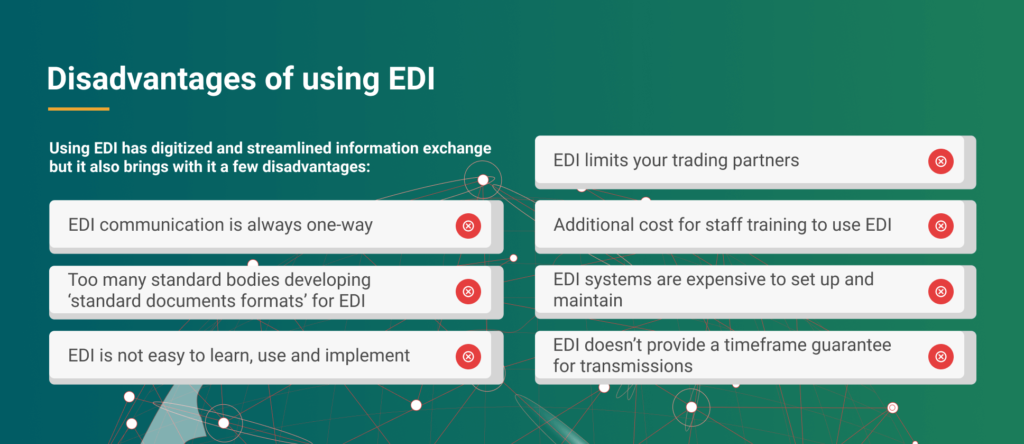
EDI is time-consuming
EDI systems don’t provide a timeframe guarantee for transmissions., though it has streamlined certain processes such as information exchange between companies, it’s often time-consuming. Usually, transmissions can take 15 to 240 minutes. This can be a major setback, especially, when you are expecting a piece of information immediately.
Too many standard bodies
These bodies develop “standard document formats” for EDI which can cause problems with cross-compatibility. There are also annual standards revisions that cause confusion and issues as one organization is using a certain format and the trading partner might still be using the older versions.
EDI systems are expensive to set up and maintain
The initial cost to set up an EDI system is time-consuming. It’s also expensive and requires heavy investment to maintain the technology. Here it poses a challenge to the small companies as they may not have the funds to invest in one.
EDI is not easy to learn, use and implement
Technology is developing every day. And as mentioned above, there are too many “standard formats of EDI”. The constant change or shift in these formats can be overwhelming for some companies to keep up with the pace of technology.
Additional cost for staff training to use EDI
To keep up with the changing formats of EDI, learning the software is important. This needs proper staff training to make them self-sufficient in order to run the EDI software. The training session adds as an extra cost. This can be expensive for some businesses.
Big players seek for companies integrated with EDI
Many large organizations today only work with those who use an EDI system. This limits trading partners you can do business with. This approach is a challenge for small companies that are unable to implement EDI because of various factors. An example of this is, Walmart. They do business only with those using EDI.
Integrate with xChange and get real-time visibility
We understand that technology can be overwhelming. That’s why Container xChange is here to help you smoothen your experience with all things related to shipping logistics. xChange provides a neutral platform for container owners and users. It connects global container logistics and provides market transparency.
So, how can xChange help you with EDI integration, you ask? Let’s use the xChange platform to understand this. You can integrate with xChange and get several advantages from that. One of them is tracking. xChange provides an application — xChange Tracking — which lets you know what’s going on with your containers at all times. With this, you, as a member of xChange, can automatically receive the latest tracking information as it populates on your xChange Tracking page.
![]()
Furthermore, you can save a lot of time by automating your sales requirements and balances. And these could also be the offers for your customers; xChange creates requirements out of these. It also finds matches for your requirements from other users. This only works through shipping EDI integration.
xChange provides comprehensive standard support for all members. We handle any EDI standards from your organization and your partners including ANSI X 12, EDIFACT, TRADACOMS, and HL7 Standards.
EDI integration with xChange helps improve your data security and tracking capabilities. Moreover, it boosts efficiency and trading relations with your customers. This is something our member, Andrea Monti, who’s a container leaser, has experienced.
“Before the integration, you had to arrange your own stocks by item and location all by yourself. One by one. Now, you don’t have to. It saves a lot of time”
 Andrea Monti, Sogese SRL
Andrea Monti, Sogese SRL
It’s time to go digital and get your hands on the most suitable EDI integration for your business. To know more about how xChange can help you get real-time visibility, increase logistics efficiency and find you a better match, click the banner below.
What can you expect from integration with xChange?
Essentially a transparent data interchange. We can,
- Save you valuable time and make sure, you get the time to focus on what really matters
- Help you improve your customer relations with faster response time and error-free processing. Rest assured of your service quality.
- Supply Gate In and Gate Out Reports, Inventories and Balances
- Give you detailed track and trace reports for all your containers
- Automate documents such as release references and BoL Details.
- Container event notifications (ETA’s Pick-up, Returns, etc.)
- More accurate search results and proposals
- Greater trust and transparency among the xChange network
In addition to these, you get real-time visibility. xChange gives you instant updates and notifications for your open and running requests. Thus, you receive better and more accurate results without manually sending us your needs and demands.
xChange provides fast and free onboarding. We integrate your system with xChange at the least possible effort from your side. And build a custom integration for you within 14 days at no cost.
So, it’s time to say goodbye to traditional emails or phone calls! You’ve everything you need at your fingertips. Save some time, money, and enjoy improved productivity.
If you want to know more about EDI integration, click the banner below, and our IT experts will help you get started.
EDI Shipping: Common FAQs
What are the main benefits of EDI?
There are many benefits of using EDI in the shipping business. Some of the benefits are as follows: - Faster and error-free processing - Automated data entry - Real-time information - Integrated communication system - Environment-friendly (eliminates the use of paper) Improve customer service Increase trading partner relations
How is EDI used in transportation?
There is a great number of transactions happening on a daily basis in the transportation business. Data interchange between two companies is automated with the help of EDI transport. The result? Millions of dollars and time are saved. Along with this, there is seamless communication across the supply chain system.
What are EDI charges?
When a forwarder organizes the exchange of electronic data to ports/customs and other government entities that need the information is how EDI charges in shipping are applied. Sometimes the fee is applied at the request of the customer or a vendor who may charge a fee for a particular service and may even bundle fees into a total package price.




